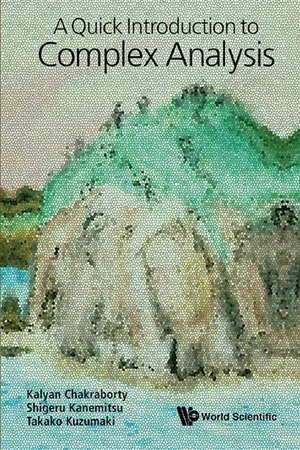
eBook - ePub
A Quick Introduction to Complex Analysis
- 208 pages
- English
- ePUB (mobile friendly)
- Available on iOS & Android
eBook - ePub
A Quick Introduction to Complex Analysis
About this book
The aim of the book is to give a smooth analytic continuation from calculus to complex analysis by way of plenty of practical examples and worked-out exercises. The scope ranges from applications in calculus to complex analysis in two different levels.
Frequently asked questions
Yes, you can cancel anytime from the Subscription tab in your account settings on the Perlego website. Your subscription will stay active until the end of your current billing period. Learn how to cancel your subscription.
No, books cannot be downloaded as external files, such as PDFs, for use outside of Perlego. However, you can download books within the Perlego app for offline reading on mobile or tablet. Learn more here.
Perlego offers two plans: Essential and Complete
- Essential is ideal for learners and professionals who enjoy exploring a wide range of subjects. Access the Essential Library with 800,000+ trusted titles and best-sellers across business, personal growth, and the humanities. Includes unlimited reading time and Standard Read Aloud voice.
- Complete: Perfect for advanced learners and researchers needing full, unrestricted access. Unlock 1.4M+ books across hundreds of subjects, including academic and specialized titles. The Complete Plan also includes advanced features like Premium Read Aloud and Research Assistant.
We are an online textbook subscription service, where you can get access to an entire online library for less than the price of a single book per month. With over 1 million books across 1000+ topics, we’ve got you covered! Learn more here.
Look out for the read-aloud symbol on your next book to see if you can listen to it. The read-aloud tool reads text aloud for you, highlighting the text as it is being read. You can pause it, speed it up and slow it down. Learn more here.
Yes! You can use the Perlego app on both iOS or Android devices to read anytime, anywhere — even offline. Perfect for commutes or when you’re on the go.
Please note we cannot support devices running on iOS 13 and Android 7 or earlier. Learn more about using the app.
Please note we cannot support devices running on iOS 13 and Android 7 or earlier. Learn more about using the app.
Yes, you can access A Quick Introduction to Complex Analysis by Kalyan Chakraborty, Shigeru Kanemitsu;Takako Kuzumaki in PDF and/or ePUB format, as well as other popular books in Mathematics & Financial Risk Management. We have over one million books available in our catalogue for you to explore.
Information
Chapter 1
A Quick Introduction to Complex Analysis with Applications
1.1The quickest introduction to complex analysis
This section serves as a review or survey material for those who are in a hurry to recall what the main ingredients in complex analysis are in three days. It presupposes some basic knowledge of complex numbers and functions etc. If you encounter something whose meaning is not clear to you, you must make a recourse to a more standard presentation of the theory in the subsequent sections.
Since complex function theory is in a sense infinitesimal calculus of complex-valued functions in the complex variable, it follows that the most fundamental ingredients in the theory are differentiation and integration; the former of which we define in the same way as with real functions, i.e. the function f(z) is differentiable at z = z0 in its domain of definition D if

exists, in which case, the limit value is denoted by f′(z0) called the derivative of f at z0. Formally this is the same as the derivative of a real function, the only difference being that the limit is taken in a planar domain D ⊂ ℂ.
On the other hand, the latter is more complicated since integration means a contour integral. However, the below-mentioned “performing the change of variable principle” makes it quite easily accessible.
Definition 1.1. We say that a complex function is analytic (or sometimes holomorphic or regular) in a domain if it is differentiable at each point of the domain, where differentiability means the existence of the derivative, and a domain (sometimes referred to as a region) mathematically means a connected set; we simply understand a domain to be a certain plane figure (⊂ ℂ) with interior and with the boundary curve. We usually assume that domains are arc-wise connected. Typical domains are the rectangles (parallelopipeds) and circles and there is no need to worry about what domains are.
We assume throughout that a curve is a piecewise smooth (Jordan) curve described by the parametric expression

E.g., the unit circle C: ∣z∣ = 1 is given by

or by
C: z = z(t) = eit, t ∈ [0, 2π],
where the complex exponential function eit, cf. §1.3.2.
By the Jordan curve theorem, such a curve encircles a ...
Table of contents
- Cover
- Title
- Copyright
- Contents
- Preface
- 1. A Quick Introduction to Complex Analysis with Applications
- 2. Applicable Real and Complex Functions
- Appendix
- Bibliography
- Index